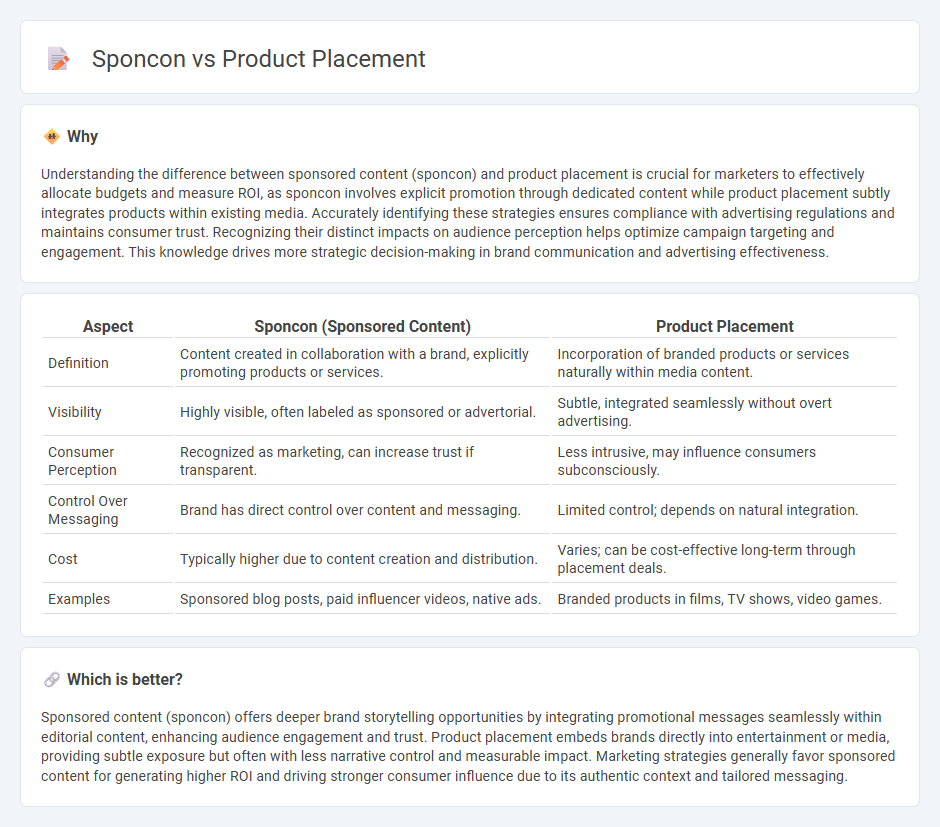
Sponsored content integrates marketing messages seamlessly within editorial content to engage audiences without overt advertising. Product placement strategically embeds branded products within films, TV shows, or videos to enhance brand visibility subtly. Explore the distinctive advantages and applications of sponsored content versus product placement to elevate your marketing strategy.
Why it is important
Understanding the difference between sponsored content (sponcon) and product placement is crucial for marketers to effectively allocate budgets and measure ROI, as sponcon involves explicit promotion through dedicated content while product placement subtly integrates products within existing media. Accurately identifying these strategies ensures compliance with advertising regulations and maintains consumer trust. Recognizing their distinct impacts on audience perception helps optimize campaign targeting and engagement. This knowledge drives more strategic decision-making in brand communication and advertising effectiveness.
Comparison Table
| Aspect | Sponcon (Sponsored Content) | Product Placement |
|---|---|---|
| Definition | Content created in collaboration with a brand, explicitly promoting products or services. | Incorporation of branded products or services naturally within media content. |
| Visibility | Highly visible, often labeled as sponsored or advertorial. | Subtle, integrated seamlessly without overt advertising. |
| Consumer Perception | Recognized as marketing, can increase trust if transparent. | Less intrusive, may influence consumers subconsciously. |
| Control Over Messaging | Brand has direct control over content and messaging. | Limited control; depends on natural integration. |
| Cost | Typically higher due to content creation and distribution. | Varies; can be cost-effective long-term through placement deals. |
| Examples | Sponsored blog posts, paid influencer videos, native ads. | Branded products in films, TV shows, video games. |
Which is better?
Sponsored content (sponcon) offers deeper brand storytelling opportunities by integrating promotional messages seamlessly within editorial content, enhancing audience engagement and trust. Product placement embeds brands directly into entertainment or media, providing subtle exposure but often with less narrative control and measurable impact. Marketing strategies generally favor sponsored content for generating higher ROI and driving stronger consumer influence due to its authentic context and tailored messaging.
Connection
Sponsored content (sponcon) and product placement both integrate brands seamlessly into media to enhance consumer engagement and brand recall. Sponcon typically involves explicit brand mentions or endorsements within digital or social media content, while product placement subtly incorporates products into entertainment such as TV shows or movies. Together, these strategies leverage narrative-driven advertising to influence audience perception and drive purchase decisions.
Key Terms
Brand Integration
Brand integration involves seamlessly embedding a product or brand into the core narrative of content, enhancing viewer engagement without disrupting storytelling flow. Unlike generic sponsored content, effective brand integration creates a natural connection between the brand and the audience by aligning with character actions, themes, or plot developments. Explore how strategic brand integration can elevate marketing impact and foster authentic consumer relationships.
Native Advertising
Product placement integrates branded products seamlessly into the content, enhancing viewer engagement without disrupting the narrative flow. Native advertising, including sponsored content (sponcon), matches the form and function of the platform, providing a less intrusive ad experience that resonates with the audience. Discover how native advertising strategies blend marketing with storytelling for maximum impact.
Influencer Partnership
Product placement integrates branded products seamlessly into influencer content, enhancing authenticity and engagement without overt promotion. Sponsored content involves explicit endorsements where influencers create dedicated posts or videos to highlight a brand or product, often driving targeted campaigns. Explore how choosing the right influencer partnership strategy can maximize brand visibility and consumer trust.
Source and External Links
Product placement - Wikipedia - Product placement is a marketing technique where specific brands or products are deliberately incorporated into films, TV programs, or other media with promotional intent, ranging from subtle appearances to prominent integration, and valued at over $20 billion in agreements as of 2021.
What Is Product Placement? Definition and Examples | Indeed.com - Product placement is an advertising technique that promotes brands and products naturally in entertainment contexts, often lasting under 10 seconds, and differs from traditional commercials by being less direct and more subtle.
Product Placement: Examples and Business Benefits (2025) - Shopify - Product placement involves paying to include products in entertainment or editorial content, such as movies or TV shows, embedding the brand organically to build awareness and engage specific audiences, with an increasing market worth over $33 billion in 2024.
 dowidth.com
dowidth.com